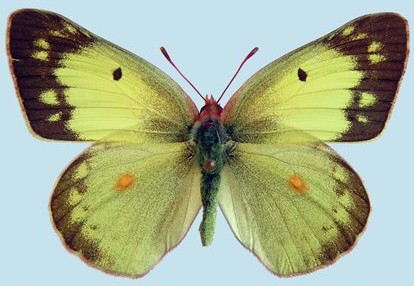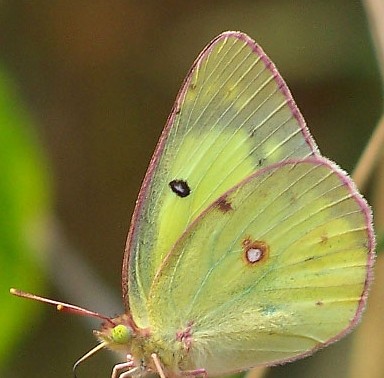 The common sulphur probably was originally a northern and eastern species but it has now spread and can be found coast to coast except in southern California, south Texas, and most of Florida. It lives in open areas such as fields, meadows, roadsides, lawns, and parks and is absent from dense forests. The dorsal side of the wings are yellow or white with a dark brown border on the top. Males are usually yellow with a solid border while females are can be yellow or white with a white spotted border. Both sexes have a spot near the middle of each wing; dark on the fore wings and yellow to orange on the hind wings. The ventral side of the wings is greenish yellow to clear yellow. Both the male and female common sulphurs can be confused for other sulphurs. The wing span is 1 1/2 to 2 3/4 inches.
The common sulphur probably was originally a northern and eastern species but it has now spread and can be found coast to coast except in southern California, south Texas, and most of Florida. It lives in open areas such as fields, meadows, roadsides, lawns, and parks and is absent from dense forests. The dorsal side of the wings are yellow or white with a dark brown border on the top. Males are usually yellow with a solid border while females are can be yellow or white with a white spotted border. Both sexes have a spot near the middle of each wing; dark on the fore wings and yellow to orange on the hind wings. The ventral side of the wings is greenish yellow to clear yellow. Both the male and female common sulphurs can be confused for other sulphurs. The wing span is 1 1/2 to 2 3/4 inches.
 Females lay chartreuse eggs singly on the leaves of host plants. Caterpillars are bright green with dark back stripe and light side stripes. They pupate after feeding and overwinter in a green chrysalis.
Females lay chartreuse eggs singly on the leaves of host plants. Caterpillars are bright green with dark back stripe and light side stripes. They pupate after feeding and overwinter in a green chrysalis.
Larval host plants include a variety of legumes such as alfalfa (Medicago sativa), soy-bean (Glycine max),white sweet-clover (Melilotus albus), white clover (Trifolium repens), red clover (Trifolium pratense), vetch (Vicia spp), deer-Vetch (Lotus spp.), Platte River milk vetch (Astragalus plattensis), ground-plum (Astragalus crassicarpus), and black locust (Robinia pseudoacacia). Although some of these are valuable crop plants they are not outstanding garden plants. Some,like ground-plum, might find a place in a wildflower garden.
 Adults nectar on milkweed (Asclepias spp.), alfalfa (Medicago sativa), dandelion (Taraxacum sp.) clover (Trifolium sp).Good garden plants include butterfly weed (Asclepias tuberosa), coneflowers (Echinacea spp., Rudbeckia spp., and Dracopis amplexicaulis), and tall verbena (Verbena bonariensis.)
Adults nectar on milkweed (Asclepias spp.), alfalfa (Medicago sativa), dandelion (Taraxacum sp.) clover (Trifolium sp).Good garden plants include butterfly weed (Asclepias tuberosa), coneflowers (Echinacea spp., Rudbeckia spp., and Dracopis amplexicaulis), and tall verbena (Verbena bonariensis.)